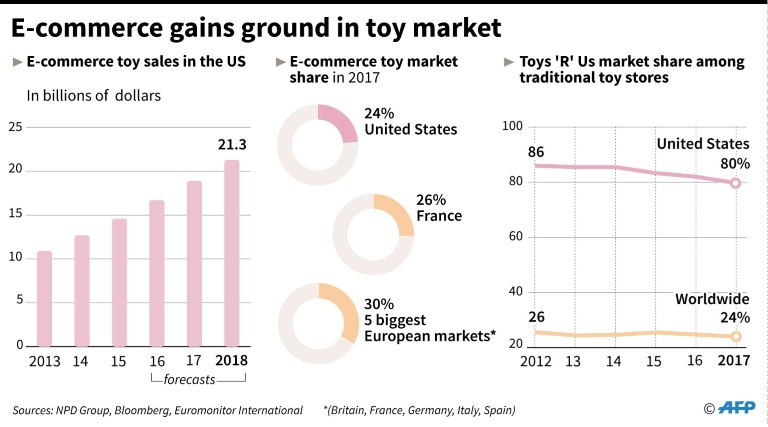Toys 'R' Us, the iconic retail chain that has captivated American kids for generations, has announced plans to shut all of its US stores, becoming one of the biggest casualties of the retail shakeout amid the rise of e-commerce.
The debt-plagued company announced in the early hours of Thursday that it has filed a motion for bankruptcy court approval to liquidate its US operations, a move that could hit 33,000 jobs.
“This is a profoundly sad day for us as well as the millions of kids and families who we have served for the past 70 years,” chief executive Dave Brandon said in a statement.
“I am very disappointed with the result, but we no longer have the financial support to continue the company’s US operations.”
The chain will shutter all 735 stores remaining in the United States, it said in a statement — down from the 881 it listed just last month. For shoppers, the company says gift cards will be honored for 30 days.
“It’s like an end of an era,” said one Brooklyn resident, who identified himself as Jorardo, shopping at the store in New York’s Times Square.
“It was not all about shopping — it was about the experience.”
The privately-held company says it is exploring a plan to sell 200 top-performing US stores in a package deal with its Canadian division.
That scenario could potentially keep the Toys ‘R’ Us brand alive, but in a much reduced form compared with its pre-Internet heyday, when it thrilled generations of children with its well-stocked aisles and its friendly mascot, Geoffrey the giraffe.
“The brand name itself still resonates — it had been the largest specialty toy retailer for years,” said Joe Feldman, senior managing director of Telsey Advisory Group, a consultancy.
“It’s just that people found that type of product for less money at Amazon and Walmart and Target and so on, and then with $5 billion in debt, it really weighed on them.”
– Post-war growth –
Started in 1948 by World War II veteran Charles Lazarus at a single store in the US capital Washington, called “Children’s Bargain Town,” the company began calling itself Toys ‘R’ Us in 1957 and went public in 1978 after a period of heavy growth.
It remained a retail force through the 1980s, but its star began to fade in the 1990s as big box stores such as Walmart and Target began selling more toys — at lower prices.
In 2005, it yielded to the pressure, and was taken private by a consortium of investors that included the KKR Group and Bain Capital — a move that saddled the company with billions of dollars of debt.

E-commerce dominates toy market
More recently, Toys ‘R’ Us has been buffeted by the competition from Amazon and other online vendors, which has generated bankruptcies across the retail sector and created a generation of “dead malls” nationwide, amid a shift away from brick-and-mortar to click-and-deliver.
In September, the company filed for bankruptcy protection, hoping to reorganize $5 billion in long-term debt.
Brandon said that for the holidays, the company wanted to continue to “put huge smiles on children’s faces.”
But the Christmas shopping season came in “well below worst case projections,” with operating earnings lagging that of the prior two seasons by $260 million, the company said in a bankruptcy court filing.
Factors contributing to the bad performance included a drop in toy and gift card sales after the bankruptcy filing and the aggressive moves of competitors who priced toys “at low-margins or as loss-leaders; prices at which the debtors could not compete because they rely exclusively on toys for profit,” the filing said.
Neil Saunders, managing director of GlobalData Retail, blamed the company’s woes on heavy debt level, a remnant of the leveraged buyout, and poor leadership.
“As the competitive dynamics of the toy market intensified, management failed to respond and evolve. As such, the brand lost relevance, customers and ultimately sales,” Saunders said in a note Wednesday.
Analysts said the demise of Toys ‘R’ Us in the US will be a hit to the toy industry. The company’s sales have fallen in recent years, but still came in at $11.5 billion in 2017, including $7.1 billion in the US.
The US toy market, the world’s largest, took in $20.7 billion in sales last year, according to NPD Group, a market research group.
“It’s a pretty significant share of the market,” said Feldman.
“It will benefit Amazon and Walmart and Target,” he said, adding that specialty shops could also do better.






